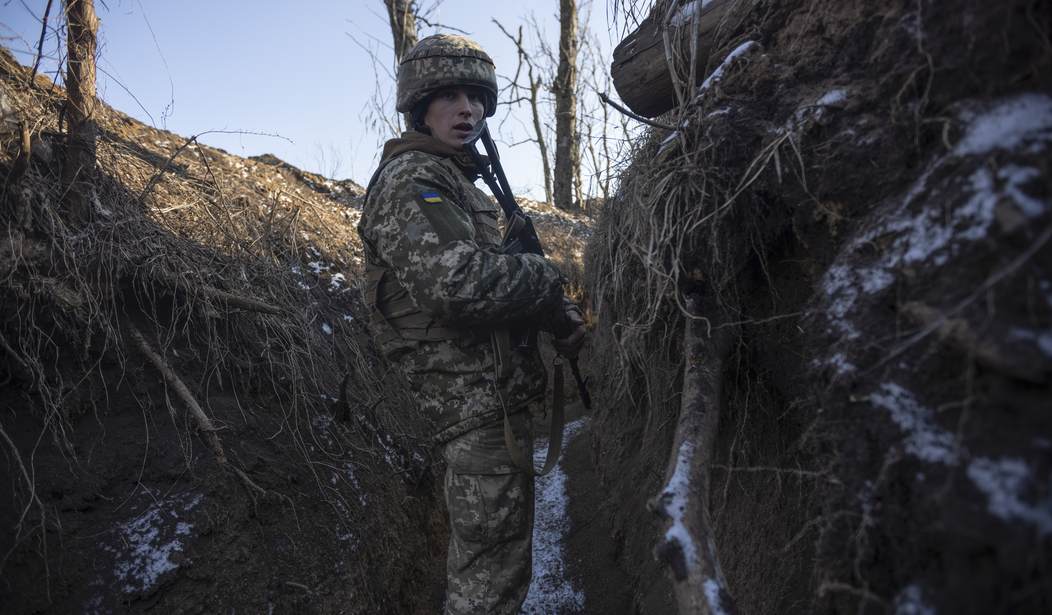Tuesday, it became evident that the Russian Army was abandoning territory in Ukraine that it seized shortly after Putin’s War began on February 24 (Russian Troops Retreat From Ukraine to Russia: Planned Redeployment or the Beginning of Collapse?). That withdrawal opened the way for Ukrainian forces to recover previously occupied territory from north of Kharkiv to the border with Russia.
What a difference a week makes. Russian positions a week ago on the left; from yesterday on the right. h/t @Militarylandnet pic.twitter.com/5gVye2hQra
— streiff (@streiffredstate) May 10, 2022
Unconfirmed but solid reports that Ukrainian troops have reached the Russian border to the North-East of Kharkiv near the town of Ternova. Today the UAF General Staff announced that Russian troops have withdrawn across the border. This unconfirmed news makes that seem more likely pic.twitter.com/UNt0aWChQi
— Nathan Ruser (@Nrg8000) May 10, 2022
The news that was unconfirmed last night is pretty solid today.
As that was happening, an article appeared in the New York Times that attempted to create a narrative different from what can be seen developing in video and intelligence summaries (h/t to earl.m61 in the comments last night).
The New York Times offering is Ukraine War’s Geographic Reality: Russia Has Seized Much of the East.
Russia’s nearly three-month-old invasion of neighboring Ukraine has been punctuated by flawed planning, poor intelligence, barbarity and wanton destruction. But obscured in the daily fighting is the geographic reality that Russia has made gains on the ground.
The Russian Defense Ministry said Tuesday that its forces in eastern Ukraine had advanced to the border between Donetsk and Luhansk, the two Russian-speaking provinces where Moscow-backed separatists have been fighting Ukraine’s army for eight years.
The ministry’s assertion, if confirmed, strengthens the prospect that Russia could soon gain complete control over the region, known as the Donbas, compared with just a third of it before the Feb. 24 invasion.
I’m not going to take the time to “fisk” this line by line, but there are three points. First, Russia lost most of the area it grabbed in Ukraine during the initial stage of the invasion. Second. It controls more of Donbas now than before the war, but the war is not over. Third, Russia’s territorial gains will only survive if Ukraine agrees to give them up as part of a ceasefire, which seems unlikely (Ukraine President Zelensky Sets His Terms to End Russia’s Aggression in Ukraine and Vladimir Putin Isn’t Laughing).
The loss of the territory north of Kharkiv is more than symbolic.
Russian logistics support is tied to railroads. A Russian unit has about three-fourths of the logistics capability of a similarly sized US unit. Russian corps and armies do not have a logistics capability. During this war, organic Russian army transport has been attritted to the point where civilian vehicles have been pressed into service. The retreat from the border puts the primary Russian rail line from Belarus and Western Russia to Donbas within range of Ukrainian artillery.
The heavy red lines are the approximate location of the Forward Edge of the Battle Area (FEBA), the heavy green lines are rail lines, and bridge symbols identify key bridges. The concentric rings represent the range of Ukrainian artillery.

Credit Def Mon on Twitter @DefMon3.
To help you orient yourself, the entire area of operations is portrayed below. The city of Izyum is the focal point for Russian Army operations in northern Donbas. It is just west of the rail intersection at the bottom right of the above map. Recall that Izyum is where the Russians nearly lost their Chief of the General Staff Valery Gerasimov last weekend, Mysterious Ammunition Dump Explosion Rocks Russia and Did Ukraine Nearly Kill Russia’s Top Military Officer?

Credit to Critical Threats on Twitter @criticalthreats.
With that rail line within reach of Ukrainian artillery or within striking distance of Switchblade drones used by special operations forces, the supply situation for the Russian Army becomes untenable.
Why is this important? According to our own Department of Defense, the effort coming out of Izyum is the main Russian effort.
U.S. believes that Russia has honed in on the northern line of advance out of Izyum into the Donbas, focused on Sloviansk.
Two other advances have stalled due to Ukrainian resistance.
Russia is in control of Popasna, after confirmation from 🇺🇦 officialshttps://t.co/v1bOEqW3Od
— Jack Detsch (@JackDetsch) May 10, 2022
(NOTE: Popansa, the town lost to the Russians, is in the green circle closest to the bottom of the above image.)
If the unit assembly areas and the logistics train of the main effort are now within artillery range, it is a safe bet that nothing good will happen.
Bigger picture: where is this headed?
U.S. believes 🇷🇺 is two weeks behind military objectives in Donbas & south.
But Putin is still striving to create a land bridge to Crimea, which 🇺🇸 officials believe he’s all but achieved (other than Mariupol).
Kyiv is still on the table.
— Jack Detsch (@JackDetsch) May 10, 2022
Russia is much more than “two weeks” behind schedule. It announced its new offensive just before Easter. Two weeks behind schedule literally means it hasn’t moved (10 Days Into Putin’s ‘New Phase’ of Russia’s Invasion of Ukraine, There Are Minor Advances but the Clock Is Ticking). This offensive was always going to be difficult. Here was my commentary when it was announced.
would only note that an axis of advance from ~Donetsk-Zaporijia is over 50 miles and it is all cross-compartment i.e. roads and rivers/streams running perpendicular to axis. That entails creating new MSRs and raised roadbeds are natural obstacles. 1/
— streiff (@streiffredstate) April 17, 2022
Russia's real problem is they are involved in three battles they can't quit. They are on the cusp of losing Kherson. If that goes, every unit N. of Dnipro is in peril. They must take Mariupol to free up units, for prestige and to secure rear areas. Finally, the Donetsk pocket. 3/
— streiff (@streiffredstate) April 17, 2022
The effort of crossing the network of rivers in the operational area is taking its toll. A river crossing is a damned hard operation if you have trained for it. If you haven’t trained for it, it is brutal. If you haven’t trained for it and the enemy has your bridging operation under observation, and within range of indirect fires, you are buggered like a fish in a jailhouse shower.
Drone footage of the destroyed 🇷🇺pontoon bridge and equipment near Bilohorivka, Luhansk Oblast. It's the main axis of the Russian attack on Severodonetsk.
📹via @Arslon_Xudosi pic.twitter.com/C4el94ba0l
— Euromaidan Press (@EuromaidanPress) May 11, 2022
A quick vehicle count shows that the tank company of a battalion tactical group was nearly annihilated. Worse than the loss of tanks is the loss of the ribbon bridge segments and their transport. Bridging equipment is always in short supply.
As a tutorial, the mnemonic for crossing an obstacle, any obstacle, is SOSR: Suppress the enemy on the far side, Obscure the place where you will reduce the obstacle, Seize the far side of the obstacle, and Reduce the obstacle. Without smoke generators laying down a blanket of smoke, the combination of Ukrainian drones and artillery makes river crossings a very costly proposition, especially when the Russians don’t seem interested in engaging in counterbattery fire with the Ukrainians. (I’ve read of the Russians setting forest/grass fires to mask bridging sites, suboptimal but better than nothing, I suppose.)
Today, this report came out of the Ukrainian General Staff.
Interesting. Ukrainian general staff saying that the Russians have gone on the defensive in a number of vital theatres. In the past when the UGS has made public claims of important shifts, they’ve usually been right. https://t.co/1aGBPXLPz9
— Phillips P. OBrien (@PhillipsPOBrien) May 11, 2022
If you aren’t familiar with the names, those areas cover everything except the three middle green circles on the Critical Threats map above.
Just a note, NBC’s report of Russian troops being pulled from their direction of attack and sent north to confront the Ukrainian counteroffensive sounds like the Russian retreat I discussed yesterday is much more of a bug-out than a carefully considered operational move.
Ukraine’s forces may be within six miles of the Russian border, according to ISW's 5/10 report. Russian forces from the Izyum area, located around 75 miles SE of Kharkiv, are reportedly redeploying north to attempt to halt Ukraine's advance.https://t.co/q7j9qjnF0N
— ISW (@TheStudyofWar) May 11, 2022
Circling back, as they say in the White House, to the New York Times article. The underlying assumption is that the Ukrainians are a people without agency. That is, they just sit around and wait for Vladimir Putin to make all the strategic moves. That isn’t how any of this works. In Colonel Harry Summers’ book about our strategic failure to understand the Vietnam War, he recounts an episode when he was a member of the US team discussing the terms of our withdrawal from that war in Paris. He was having lunch with his counterpart, a North Vietnamese colonel.
“You know you never defeated us on the battlefied,” said the American colonel.
The North Vietnamese colonel pondered this remark a moment. “Thbat may be so,” he replied, “but it also irrlevant.”
That sums up the points made in the NYT article. Russia may occupy most of Donbas, but that is becoming increasingly irrelevant as it looks like it doesn’t have the combat power to make those gains stick. Given the present set of facts, the presumption that Volodymyr Zelensky is waiting with bated breath for Vladimir Putin to condescend to negotiate with him is ludicrous and juvenile.














Join the conversation as a VIP Member